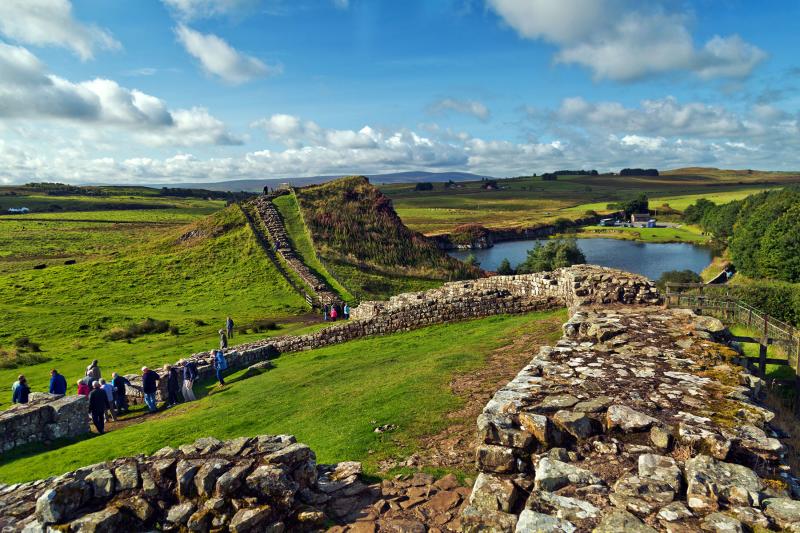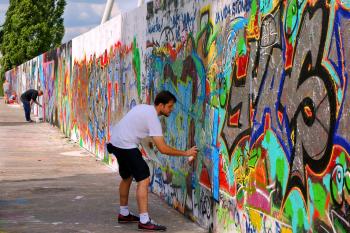Europe's famous walls
Appears in the Online Edition, October 2018.
I'm so glad borders and walls are out of fashion in Europe. The continent's many proud nations don't always get along, but they have learned to respect each other -- making it possible for peace to flourish.
Historically, though, Europe has a rich past when it comes to wall building. At one point or another, most of Europe's great cities -- Paris, London, Rome, Florence, Milan, Barcelona, Vienna and many more -- were all contained within walls, constructed during ancient and medieval times to defend against invaders. Most of these walls were torn down long ago to allow cities to expand beyond their historic centers. But some remain intact and well-preserved; in places like Dubrovnik (Croatia), Rothenburg (Germany), and Carcassonne (France), visitors can actually stroll atop these city walls.
One of my favorite ancient wall experiences is Hadrian's Wall, the remains of the fortification built by the Romans occupying Britain nearly 2,000 years ago. This great stone wall stretched 73 miles from coast to coast across the narrowest part of northern England, where Britannia stopped and the barbarian land that would someday be Scotland began.
More than just a simple barrier, Hadrian's Wall was a cleverly designed military rampart manned by 20,000 troops. At every mile there was a small fort guarding a gate. In recent decades, two of these forts have been turned into museums, where visitors can see the ruins up close, view ancient artifacts, and get a sense of life in this distant corner of Europe. Pondering these desolate ruins, you can imagine the bleakness of being a young Roman soldier stationed here centuries ago.
Hadrian's Wall is also much loved by hikers, who enjoy following the wall as it meanders up and down the natural contours of the land. For years, I never ventured beyond the museums and car-park viewpoints. But on a recent visit, I finally had time on a sunny late afternoon to hike the wall. Scrambling along Roman ruins, all alone with the sound of the wind, I took a moment to just absorb the setting -- surveying vast expanses from rocky crags that seemed to rip across the island like a snapshot freezing some horrific geological violence in mid-action.
While a visit to Hadrian's Wall is intriguing, for me, the most poignant and memorable wall experiences are those from Europe's recent past. These walls, once produced out of fear and intolerance, now symbolize peace and progress.
For example, during the Troubles -- the 30-year conflict that wracked Northern Ireland -- so-called "peace walls" went up all over Belfast to separate the two sectarian communities: Catholic Nationalists and Protestant Unionists. But now, instead of helping to keep the peace by segregating the two groups, these walls offer a place for visitors to leave messages of hope.
Like the peace walls in Belfast, the Lennon Wall in Prague is slathered in graffiti and ideas about peace, love and freedom. Back in Cold War times, when the Czech people were like birds locked in a cage, John Lennon and the Beatles' song lyrics gave them hope and vision. When Lennon was killed in 1980, this large wall near the Charles Bridge was spontaneously covered with memorial graffiti. Night after night, the police would paint over the "All You Need Is Love" and "Imagine" graffiti. And day after day, it would reappear. Today the wall remains a colorful and nostalgic place to visit.
Of course, the most famous wall from Cold War times is the 96-mile-long barrier that was built in 1961, encircling West Berlin and making it an island of freedom in communist East Germany. While most of the Wall was torn down decades ago, remnants remain, including at the Berlin Wall Memorial, where a long stretch has been preserved as a memorial to the victims of the Cold War.
The memorial features two museums and a long, narrow park that runs for nearly a mile alongside the most complete surviving stretch of the wall. The park is dotted with memorials and information displays, and occupies what was once the notorious "death strip" -- the no-man's-land between East and West where an obstacle course of barbed wire, tire-spike strips, and other devices was designed to stop would-be escapees.
The memorial ends at the Mauerpark ("Mauer" is German for "wall"). Standing on a ridge next to a fragment of the Wall on a recent sunny Sunday, I surveyed the scene. The death strip now hosts the world's biggest karaoke party, kids run around the playground ... and the Wall is now a canvas for spray-painters.
I've seen a lot of walls in my travels, and they're always a thought-provoking experience. They're also a hopeful reminder that while struggles remain, Europe has tackled differences -- by tearing down walls and, instead, building bridges between its diverse citizens.
(Rick Steves (www.ricksteves.com) writes European travel guidebooks and hosts travel shows on public television and public radio. Email him at [email protected] and follow his blog on Facebook.)


